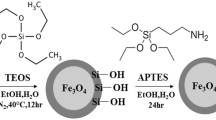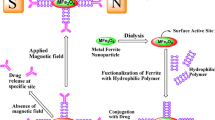Abstract
The objective of this research was to compare the effects of two different surfactants on the physicochemical properties of thermo-responsive poly(N-isopropylacrylamide-acrylamide-allylamine) (PNIPAAm-AAm-AH)-coated magnetic nanoparticles (MNPs). Sodium dodecyl sulfate (SDS) as a commonly used surfactant in nanoparticle formulation process and Pluronic F127 as an FDA approved material were used as surfactants to synthesize PNIPAAm-AAm-AH-coated MNPs (PMNPs). The properties of PMNPs synthesized using SDS (PMNPs-SDS) and PF127 (PMNPs-PF127) were compared in terms of size, polydispersity, surface charge, drug loading efficiency, drug release profile, biocompatibility, cellular uptake, and ligand conjugation efficiency. These nanoparticles had a stable core–shell structure with about a 100-nm diameter and were superparamagnetic in behavior with no difference in the magnetic properties in both types of nanoparticles. In vitro cell studies showed that PMNPs-PF127 were more cytocompatible and taken up more by prostate cancer cells than that of PMNPs-SDS. Cells internalized with these nanoparticles generated a dark negative contrast in agarose phantoms for magnetic resonance imaging. Furthermore, a higher doxorubicin release at 40 °C was observed from PMNPs-PF127, and the released drugs were pharmacologically active in killing cancer cells. Finally, surfactant type did not affect the conjugation efficiency to the nanoparticles when folic acid was used as a targeting ligand model. These results indicate that PF127 might be a better surfactant to form polymer-coated magnetic nanoparticles for targeted and controlled drug delivery.







Similar content being viewed by others
References
Bao H, Chen Z et al (2006) Preparation of magnetic nanoparticles modified by amphiphilic copolymers. Mater Lett 60:2167–2170
Blanco E, Kessinger CW et al (2009) Multifunctional micellar nanomedicine for cancer therapy. Exp Biol Med (Maywood) 234(2):123–131
Brannon-Peppas L, Blanchette JO (2004) Nanoparticle and targeted systems for cancer therapy. Adv Drug Deliv Rev 56(11):1649–1659
Chastek TT, Wadajkar A et al (2010) Polyglycol-templated synthesis of poly(N-isopropylacrylamide) microgels with improved biocompatibility. Colloid Polym Sci 288:105–114
Douziech-Eyrolles L, Marchais H et al (2007) Nanovectors for anticancer agents based on superparamagnetic iron oxide nanoparticles. Int J Nanomed 2(4):541–550
Guo W, Hinkle GH et al (1999) 99mTc-HYNIC-folate: a novel receptor-based targeted radiopharmaceutical for tumor imaging. J Nucl Med 40(9):1563–1569
Gupta AK, Gupta M (2005) Cytotoxicity suppression and cellular uptake enhancement of surface modified magnetic nanoparticles. Biomaterials 26(13):1565–1573
Hattori Y, Ding WX et al (2007) Highly efficient cationic hydroxyethylated cholesterol-based nanoparticle-mediated gene transfer in vivo and in vitro in prostate carcinoma PC-3 cells. J Control Release 120(1–2):122–130
Kabanov AV, Alakhov VY (2002) Pluronic block copolymers in drug delivery: from micellar nanocontainers to biological response modifiers. Crit Rev Ther Drug Carrier Syst 19(1):1–72
Kabanov AV, Batrakova EV et al (2002) Pluronic block copolymers as novel polymer therapeutics for drug and gene delivery. J Control Release 82(2–3):189–212
Kabanov AV, Batrakova EV et al (2003) An essential relationship between ATP depletion and chemosensitizing activity of Pluronic block copolymers. J Control Release 91(1–2):75–83
Kabanov A, Zhu J et al (2005) Pluronic block copolymers for gene delivery. Adv Genet 53:231–261
Koňák Č, Pánek J et al (2007) Thermoresponsive polymeric nanoparticles stabilized by surfactants. Colloid Polym Sci 285(13):1433–1439
Koneracka M, Zavisova V et al (2008) Magnetic properties of encapsulated magnetite in PLGA nanospheres. Acta Phys Polonica A 113(1):595–598
Lim YT, Noh YW et al (2008) Biocompatible polymer-nanoparticle-based bimodal imaging contrast agents for the labeling and tracking of dendritic cells. Small 4(10):1640–1645
Lin JJ, Chen JS et al (2009) Folic acid-Pluronic F127 magnetic nanoparticle clusters for combined targeting, diagnosis, and therapy applications. Biomaterials 30(28):5114–5124
McBain SC, Yiu HH et al (2008) Magnetic nanoparticles for gene and drug delivery. Int J Nanomed 3(2):169–180
Narain R, Gonzales M et al (2007) Synthesis of monodisperse biotinylated p(NIPAAm)-coated iron oxide magnetic nanoparticles and their bioconjugation to streptavidin. Langmuir 23(11):6299–6304
Oh KT, Bronich TK et al (2004) Micellar formulations for drug delivery based on mixtures of hydrophobic and hydrophilic Pluronic block copolymers. J Control Release 94(2–3):411–422
Pinkernelle J, Teichgräber U et al (2005) Imaging of single human carcinoma cells in vitro using a clinical whole-body magnetic resonance scanner at 3.0 T. Magn Reson Med 53(5):1187–1192
Pouponneau P, Leroux J et al (2009) Magnetic nanoparticles encapsulated into biodegradable microparticles steered with an upgraded magnetic resonance imaging system for tumor chemoembolization. Biomaterials 30:6327–6332
Puech P, Huglo D et al (2009) Imaging of organ-confined prostate cancer: functional ultrasound, MRI and PET/computed tomography. Curr Opin Urol 19(2):168–176
Rahimi M, Kilaru S et al (2008) Synthesis and characterization of thermo-sensitive nanoparticles for drug delivery applications. J Biomed Nanotechnol 4(4):482–490
Rahimi M, Yousef M et al (2009) Formulation and characterization of a covalently coated magnetic nanogel. J Nanosci Nanotechnol 9(7):4128–4134
Rahimi M, Wadajkar A et al (2010) In vitro evaluation of novel polymer-coated magnetic nanoparticles for controlled drug delivery. Nanomedicine 6(5):672–680
Ramirez LP, Landfester K (2003) Magnetic polystyrene nanoparticles with a high magnetite content obtained by miniemulsion processes. Macromol Chem Phys 204(1):22–31
Sahoo SK, Ma W et al (2004) Efficacy of transferrin-conjugated paclitaxel-loaded nanoparticles in a murine model of prostate cancer. Int J Cancer 112(2):335–340
Serda RE, Adolphi NL et al (2007) Targeting and cellular trafficking of magnetic nanoparticles for prostate cancer imaging. Mol Imag 6(4):277–288
Sun C, Lee JS et al (2008) Magnetic nanoparticles in MR imaging and drug delivery. Adv Drug Deliv Rev 60(11):1252–1265
Wu X, Pelton RH et al (1994) The kinetics of poly(N-isopropylacrylamide) microgel latex formation. Colloid Polym Sci 272(4):467–477
Yu MK, Jeong YY et al (2008) Drug-loaded superparamagnetic iron oxide nanoparticles for combined cancer imaging and therapy in vivo. Angew Chem Int Ed Engl 47(29):5362–5365
Acknowledgements
TEM was performed at the University of Texas Southwestern Medical Center Molecular and Cellular Imaging Facility. This research was supported by the Department of Defense (Grant No.W81XWH-09-1-0313).
Author information
Authors and Affiliations
Corresponding author
Additional information
N. A. Alsmadi and A. S. Wadajkar contributed equally to this study.
Rights and permissions
About this article
Cite this article
Alsmadi, N.A., Wadajkar, A.S., Cui, W. et al. Effects of surfactants on properties of polymer-coated magnetic nanoparticles for drug delivery application. J Nanopart Res 13, 7177–7186 (2011). https://doi.org/10.1007/s11051-011-0632-4
Received:
Accepted:
Published:
Issue Date:
DOI: https://doi.org/10.1007/s11051-011-0632-4




